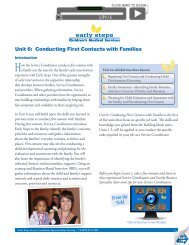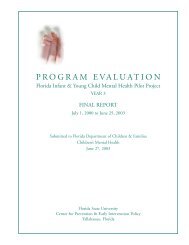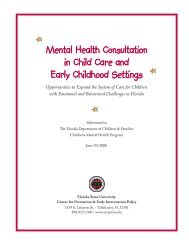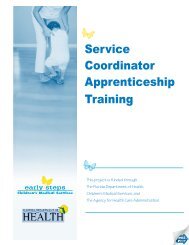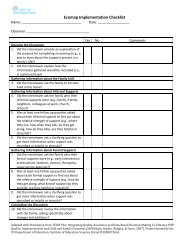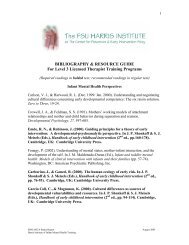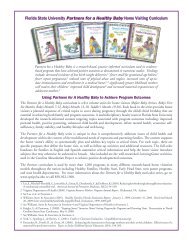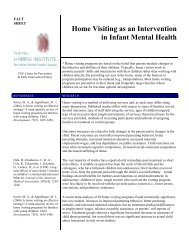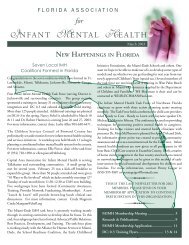Using Partners for A Healthy Baby to Achieve Program Outcomes
Using Partners for A Healthy Baby to Achieve Program Outcomes
Using Partners for A Healthy Baby to Achieve Program Outcomes
You also want an ePaper? Increase the reach of your titles
YUMPU automatically turns print PDFs into web optimized ePapers that Google loves.
How the <strong>Partners</strong> <strong>for</strong> a <strong>Healthy</strong> <strong>Baby</strong> Curriculum Aligns with Core Elementsof Evidence-Based Home Visitation ServicesRecently, the National Home Visitation Steering Committee* (March 2009) proposed four Core Elements of EvidencebasedHome Visitation Services. The elements address program outcomes, program models and standards, programrecipients, and program providers. The <strong>Partners</strong> <strong>for</strong> a <strong>Healthy</strong> <strong>Baby</strong> curriculum is used in numerous programs that meetthe Core Elements. Positive outcomes achieved by evidence-based programs using the <strong>Partners</strong> curriculum are cited below.Core Element 1: Demonstrate ongoing positive outcomes that enhance child health and development by improvingprenatal health; pregnancy outcomes; child health; physical, cognitive, language and social emotional development;school readiness; academic success; positive parenting practices; parent involvement; reductions in child abuse, neglectand injury; birth intervals between pregnancies; family stability; economic self sufficiency; and maternal employment.Positive Birth <strong>Outcomes</strong>• The risk of delivering a low birth weight (LBW) baby was significantly lower <strong>for</strong> the <strong>Healthy</strong> Families New York(HFNY) mothers (5.1%) than <strong>for</strong> the control group mothers (9.8%).• HFNY mothers delivered fewer small <strong>for</strong> gestational age (SGA) babies (8.8%) than control group mothers (11.6%).—Lee, E., Mitchell-Herzfeld, S., Lowenfels, A., Green, R., Dorabawila, V., & DuMont, K. (2009). Reducing low birth weight through homevisitation: A randomized controlled trial. American Journal of Preventive Medicine, 36(2), 154-160.• Teens in the Virginia Resource Mothers (VRM) program had fewer low birth weight deliveries compared <strong>to</strong> overallteen state rates (7.7% vs. 10.3% in 2006) and (8.9% vs. 10.6% in 2007).—Virginia Department of Health. (2008). Virginia Resource Mothers <strong>Program</strong> Annual Report. Richmond, VA: Author.• Mothers who participated in the Tennessee HUGS program had an average gestational age of 37.5 weeks and anaverage number of prenatal visits of 10.0 per mother.—Tennessee Department of Health, Maternal and Child Health. (2011). Tennessee Home Visiting <strong>Program</strong>s Annual Report: July 1, 2009–June 30,2010. Nashville, TN: Author. Retrieved from http://health.state.tn.us/statistics/PdfFiles/Home_Visiting_<strong>Program</strong>s_Annual_Report_2010.pdfReduction in Child Abuse• A five-year evaluation, which used a quasi experimental design, found that children in <strong>Healthy</strong> Families Florida were3.7 times less likely than the comparison group <strong>to</strong> experience child maltreatment.• There was 58% less child abuse in families who received three or more years of service or completed the programcompared <strong>to</strong> families who received less than 3 months of services or no services.• The rate of child maltreatment <strong>for</strong> HFF participants was 20% less than <strong>for</strong> families in the target service areas.—Williams, Stern & Associates (2005). <strong>Healthy</strong> Families Florida Evaluation Report: January 1, 1999–December 31, 2003. Retrieved March 26,2009 from www.healthyfamiliesfla.org/pdfs/Final_Evaluation_1999-2003.pdf• Only one substantiated incidence of child maltreatment was reported <strong>for</strong> participants in the Cabarrus Health Alliance’sIntensive Home Visiting <strong>Program</strong> <strong>for</strong> Pregnant and Parenting Teens from 2004-2009.—Stepping S<strong>to</strong>nes Intensive Home Visiting <strong>Program</strong>. Quarterly Reports 2004–2009. Cabarrus Health Alliance, North Carolina.—Knight, S., & Patterson, J. (2008). “Stepping S<strong>to</strong>nes” Intensive Home Visiting <strong>Program</strong> <strong>for</strong> Pregnant and Parenting Teens. Presentation <strong>to</strong> NorthCarolina Smart Start Conference, May 6, 2008.• A <strong>to</strong>tal of 98% (1,100 of 1,133) of the children enrolled in the Tennessee CHAD program were free of child abuseand neglect as measured by DCS reported involvement in prior 12 months.• A <strong>to</strong>tal of 98.8% (1,387/1404) of the children served by Tennessee <strong>Healthy</strong> Start program did not exhibit signs ofabuse or neglect.—Tennessee Department of Health, Maternal and Child Health. (2011). Tennessee Home Visiting <strong>Program</strong>s Annual Report: July 1, 2009–June 30,2010. Nashville, TN: Author. Retrieved from http://health.state.tn.us/statistics/PdfFiles/Home_Visiting_<strong>Program</strong>s_Annual_Report_2010.pdf*Children’s Defense Fund, CLASP, CWLA, Fight Crime: Invest in Kids, Home Instruction <strong>for</strong> Parents of Preschool Youngsters, National ChildAbuse Coalition, Parents as Teachers National Center, Parent-Child Home <strong>Program</strong>, Prevent Child Abuse America/<strong>Healthy</strong> Families America,and Voices <strong>for</strong> America’s Children.2 Florida State University <strong>Partners</strong> <strong>for</strong> a <strong>Healthy</strong> <strong>Baby</strong> • www.cpeip.fsu.edu • September 2011




